Usage continues to stabilize, people celebrated religious holidays virtually, and the Verizon Network team quickly responded to severe weather

4/15 Update: Verizon Network Report
While continuing to work and learn from home slows the spread of COVID-19, network usage continues to normalize. Today’s Verizon Network Report shows a week-over-week (Monday vs. Monday) decrease of 5% in voice minutes and a 3% decrease in text messages. For the second straight week, Verizon reports that data usage is basically flat or down slightly week-over-week — including gaming, streaming video, virtual private network (VPN) connections (which allow people to create a secure connection over a public network like the internet to reach a private network), web browsing and social media — indicating people have settled into their new routines.
Life goes on, even in the midst of a global health crisis
While safe distancing at home, many Verizon customers observed the holiday weekend in new ways. Use of collaboration tools like video teleconferencing during Easter Sunday was up 36% compared to the prior Sunday, and up 13% during Passover compared to the previous week. Text messages were also up 28% Sunday over Sunday. These numbers indicate many chose to celebrate the holidays via virtual meals, gatherings and services with friends and family online.
Connecting with family likely influenced viewing choices during the holidays. After multiple weeks of high-energy action films proving to be the most popular titles, family-friendly content leads this week’s Fios Video on Demand (VOD) charts.
Here are the most popular VOD films last week:
-
Trolls World Tour
-
Star Wars: The Rise of Skywalker
-
Onward
-
Little Women
-
Jumanji: The Next Level
Severe Weather Response
In addition to the global health crisis and a holiday weekend, severe weather and tornadoes ripped through the South causing significant damage and power outages for millions. With damage to network facilities, the Verizon Network team quickly deployed mobile cell towers and mobile satellite cell equipment to re-establish communications in the wake of the storm. Mobile satellite cell sites were also deployed at Emergency Operations Command centers in the region to provide additional coverage and to aid in search and rescue operations. Power is still out of service in many locations and Verizon continues to run many sites on backup generator power throughout the region to provide service until both fiber and power can be restored. These efforts have been critical to keeping the network up and running for our customers.
“Our Network team is responding to all major events affecting our communities,” said Kyle Malady, Chief Technology Officer for Verizon. “I’m very proud of our team of engineers and technicians that are working hard to provide connections during this dynamic global health crisis, severe weather and national holidays all at the same time. We know how critical our communications systems are in each of these situations, and we continue to be there to support our customers and first responders.”
4/9 Update: Verizon Network Report
After weeks of significant increases in voice and data usage as a result of millions of people transitioning to working from home, distance learning and virtual socializing, new routines and usage behaviors are stabilizing, according to the latest Verizon Network report.
“While usage in key categories is still up compared to a typical day, the large increases we saw over the first four weeks of this transition have started to normalize,” said Kyle Malady, Chief Technology Officer at Verizon. “While we are still in an unprecedented situation and are monitoring the network extremely closely 24×7, we may be seeing the tail end of the large variations in customer usage behaviors we have seen the last few weeks.”
Today’s report shows week-over-week declines in traffic on virtual private networks (VPNs), which allow people to create a secure connection over a public network (like the internet) to reach a private network, downloads of songs and apps, web, social media and voice minutes of use; no changes week-over-week in video streaming; and only a slight increase in gaming:
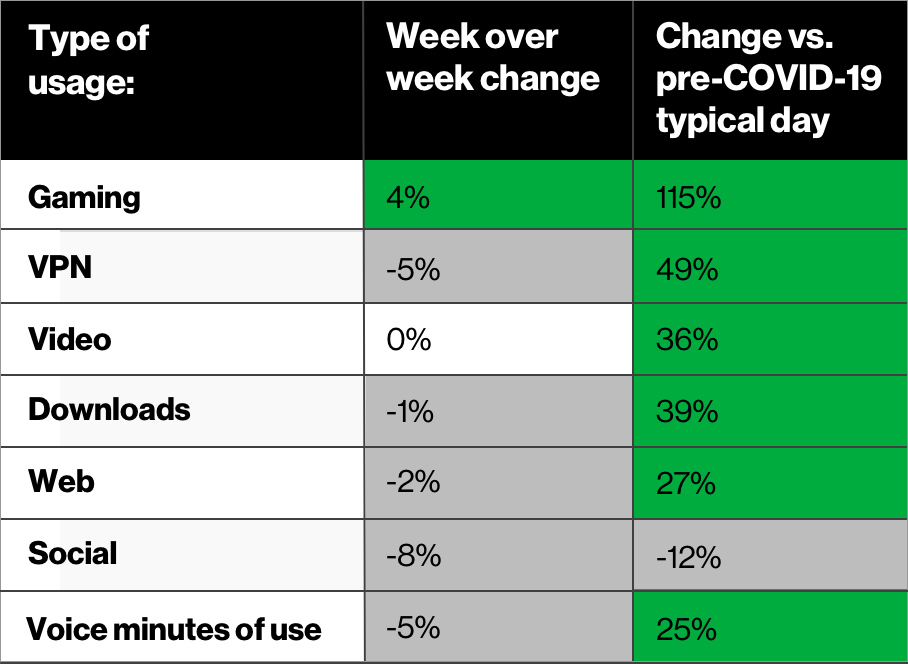
As new routines emerge, on-demand entertainment is taking center stage. On-demand movie viewing is up 32% compared to the typical pre-COVID-19 average weekly viewing. Customers have also embraced TV series filled with action, suspense and comedy.
Last weekend, the top 5 Fios Video on Demand HD titles were:
1. 1917
2. Bad Boys for Life
3. Onward
4. Star Wars: The Rise of Skywalker
5. Jumanji: The Next Level
The top 5 Fios on-demand TV series viewed last week include:
1. Homeland
2. Westworld
3. Keeping Up with the Kardashians
4. Curb Your Enthusiasm
5. Outlander
“I really could not be more proud of Verizon’s engineers and technicians,” continued Malady. “Through a very unpredictable time, this team monitored and adjusted network resources as customer behaviors shifted to ensure reliability and availability of critical communications services when they have been needed most. We are not out of this yet – we’re all in it together – and our team will continue to vigilantly monitor and adjust to support the needs of our customers and first responders.”
BASKING RIDGE, NJ – More and more people across the country appear to be following shelter-in-place mandates as cell site handoffs continued to decline. Cell site handoffs are the times when a data session moves from one cell site to another as users walk or drive around. According to the latest Verizon Network Report, handoffs have decreased by 35% nationally compared to a typical day, down another 6% from what was reported last week. Handoffs are influenced by geography and network design, and provide a directional view of the changing patterns of American life.
4/7 Update: Verizon Network Report
Verizon’s New York Metro and Upstate New York markets showed the biggest declines at 51% and 61% respectively vs. a typical day. Other Verizon markets like the Mid-Atlantic/Greater Washington, D.C. metro area and New England also showed significant declines of 39% and 41%, respectively, with the Southern California and Northern California markets both declining 41% vs. a typical day.
In the southeast, mobile handoffs are significantly down with week-over-week drops of 18% in the Georgia/Alabama market, declines of 16% in the Carolinas/Tennessee market, 10% in Florida, and 9% in the Gulf Coast market.
As more people are staying home, Verizon Media Group reports they are engaging with news about COVID-19 in record numbers. Over 300 million users globally have accessed Verizon media properties’ coronavirus content. In March 2020, the average total time spent per weekend day increased by 123% year-over-year.
4/2 Update: Verizon Network Report
The Northeast and Mid-Atlantic regions appear to have the most people in the nation staying at home, according to the latest Verizon Network Report. Mobile handoffs, the times when a data session moves from one cell site to another as users walk or drive around, are significantly down in the New York Metro area (-53%) and Upstate New York (-49%) vs. a typical day. Other metro regions like the Mid-Atlantic/greater Washington, D.C. metro area and New England follow with declines of -39% and -37%, respectively, with Southern California declining -35% and Northern California down -27%. Nationally, mobile handoffs have dropped -29% versus a typical day.
“The significant decrease in handoffs is a very good indication that people in some of our hardest hit communities are listening to local authorities’ requests to stay home,” said Kyle Malady, Chief Technology Officer for Verizon. “As people stay home to work, engage in online meetings and share social experiences virtually, our networks continue to support them.”
The report also found people who are staying indoors continue to collaborate at much greater levels.
“This week we have seen traffic from collaboration tools increase nearly 10 times over a typical day,” said Malady. “Being able to see and speak with colleagues, friends and family has become increasingly important to people even as they physically distance themselves at greater rates.”
As online collaboration climbs, growth in other internet uses has started to stabilize.
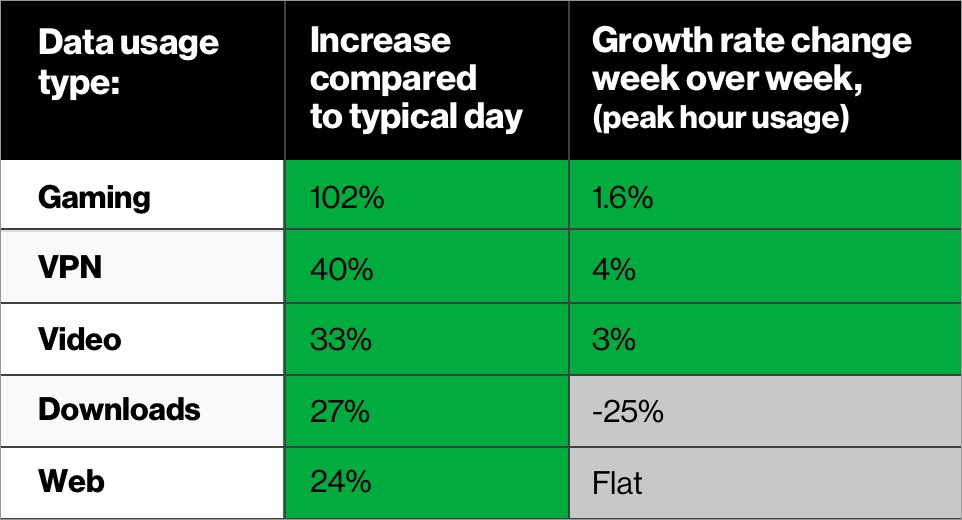
*Downloads include songs, apps, etc.
“We expect to see some traffic growth of specific applications continue even as the changes start to slow for some others,” said Malady. “Our engineers are keeping a close eye on pattern changes and indicators, and we’re ready to adjust our resources to meet the continuously changing needs of our customers.”
BASKING RIDGE, NJ – While things are far from normal, it seems Verizon customers are creating a new weekend normal of fun and fellowship, according to the latest Verizon Network Report.
3/31 Update: Verizon Network Report
The latest Network report shows that peak traffic on VPN, which allows people to create a secure connection over a public network (like the internet) to reach a private network, was down 44% this past weekend over the peak VPN usage on weekdays. The report also shows a 2% increase in peak video traffic, a 7% increase in web traffic and a 3% increase in gaming over peak weekday traffic.
And while taking a break from work, people are still finding ways for Sunday fellowship. With a massive move to online Sunday morning services among many religious organizations the past few weeks, Verizon is seeing a steady increase in Sunday morning collaboration tool usage (8 AM– 12 PM ET), including a 163% increase between Sunday March 15 to the 22 and another 224% March 22 compared to this past Sunday, March 29.
On the entertainment front, Fios TV customers are turning to Video on Demand content, with a 49% increase week-over-week from March 14 through March 21, and stayed consistent through the weekend.
This weekend, the top 5 Fios Video on Demand HD titles were:
- 1917
- Jumanji: The Next Level
- The Invisible Man
- Onward
- Knives Out
In addition, people continue to stay up-to-date with the news. The Verizon Media brand portfolio continues to see a surge in engagement with more than two billion page views and one billion video streams related to COVID-19 news and content. Engagement on Yahoo Mail is also up 22% as people shop, share and socialize from home.
“Our engineers build our networks to provide great experiences and stay ahead of demand, whether customers are streaming their favorite TV show, video chatting with family and friends, or providing critical services on the frontline of this crisis,” said Kyle Malady, Verizon Chief Technology Officer.
3/26 Update: Verizon Network Report
More than halfway through the second full week of large-scale working-from-home, the use of online collaboration tools such as conference calling applications continues to rise significantly, according to the latest Verizon Network Report. Week over week, there has been a 47% increase in use of collaboration tools on Verizon’s networks. The use of these applications drops sharply during weekends, indicating they are being used primarily for remote work and online learning.

Traffic using Virtual Private Networks (VPN), which allow people to create a secure connection over a public network (like the internet) to reach a private network, also continues to increase. It is up another 9% week over week and up 52% over a typical day.
Verizon’s wireless and broadband networks handled more than 218,000 terabytes of data this past Monday alone. That equates to 106 million hours of streaming content, 190 billion photo uploads or 38 billion songs downloaded. The network continues to perform well.
“We are seeing tremendous amounts of usage across our networks as our customers are finding new and important ways of staying connected,” said Kyle Malady, Chief Technology Officer for Verizon. “Our engineers are carefully watching changes and trends in network usage, which seems to be normalizing, and are adjusting capacity as needed. Our networks are meeting the shifting demands well and continue to show strong, consistent performance for our customers.”
BASKING RIDGE, N.J. – The Verizon network is now handling twice the number of wireless calls on weekdays compared to Mother’s Day, according to the latest Verizon Network report. Verizon’s fiber optic and wireless networks continue to perform well, meeting the shifting demands of customers during this unprecedented time.
3/24 Update: Verizon Network Report
Americans Increasingly Staying in Place
Mobile handoffs – the times when a data session moves from one cell site to another as users walk or drive around, are down 27% vs. a typical week, indicating people are increasingly staying in place. As people are being asked to stay physically distant, they are finding alternate ways to stay connected through a significant rise in calls, text and picture messages.
Verizon is reporting:
- An average of nine billion texts each day on its wireless network.
- An average of 800 million wireless calls each weekday – nearly twice the call volume of Mother’s Day.
- Call durations are up 33% vs. a typical day, meaning not only are people calling more, they are staying on the phone longer.
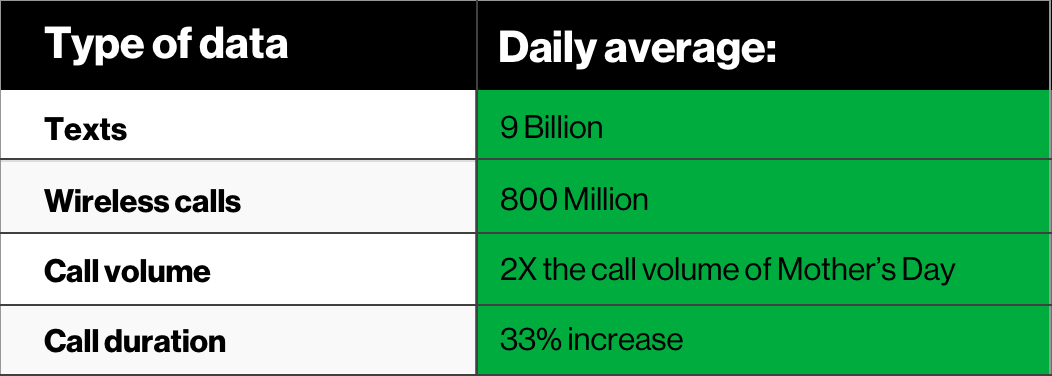
“Typically, Mother’s Day is always our highest Sunday call volume,” said Kyle Malady, Chief Technology Officer for Verizon. “The weekday calling numbers are now significantly exceeding the national holiday honoring Mom.
“The Verizon networks are built to keep people connected and though we are seeing changes in how people are connecting, we see the desire to stay connected growing,” said Malady. “Our networks are meeting customers’ changing habits. In small pockets where there has been a significant increase in usage, our engineers are quickly adding capacity to meet customers’ demand.”
Update: Verizon Network Report, reflecting March 12 compared to March 19
As Americans spend their first full week in the new temporary normal and staying at home, they are finding their voices again. Voice usage, long declining in the age of texting, chat and social media, is up 25 percent in the last week. Verizon customers are benefitting from a long-standing practice of no data caps on Verizon home broadband services.
The network report shows the primary driver of increased voice usage is accessing conference calling numbers. In addition, people are talking longer on mobile devices with: wireless voice usage notching a 10 percent increase and calls lasting 15 percent longer.
“For years we’ve seen a steady decline in the amount of time people spend talking to one another, especially on wireless devices,” said Kyle Malady, Chief Technology Officer at Verizon. “The move to staying at home has reignited people’s hunger to stay connected, voice-to-voice. Verizon’s fiber optic and wireless networks are continuing to meet the shifting demands of customers and continue to perform well.”
No data caps on Verizon home broadband internet
Verizon customers are also benefiting from the company’s long-standing practice of no data caps on its home broadband internet.
How Americans are spending their time, by the numbers:
- Total voice usage on Verizon networks is up 25%, primary driver: accessing conference call services
- Wireless voice usage up 10%, call durations up 15%
- VPN traffic is up 25%
- Web traffic is up 22%
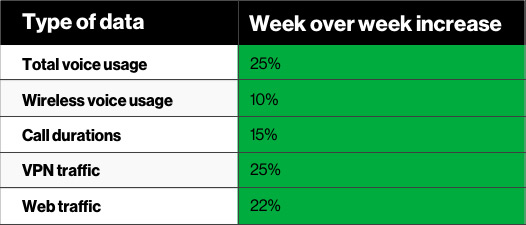
*Based on peak data hour usage March 12 vs. March 19.
*Usage is expected to fluctuate over time; we could see new applications emerge based on customer usage patterns as more people telecommute and more students are at home.
“We are in the first full week of this new American routine and we are certainly starting to see some patterns emerge. We anticipate we will see additional significant shifts in usage over the next few weeks as people adjust and adapt to the changing circumstances,” said Malady. “Our engineers are continuing to closely monitor network usage patterns 24×7 and stand ready to adjust resources as changing demands arise.”
3/17 Update: Verizon Network Report, reflecting March 9 compared to March 16, 2020
The latest week-over-week numbers during peak hour usage showed many people are turning to gaming as a way to pass the time, with the technology leader seeing a 75% increase over its networks. Video streaming increased by more than 12% and overall web traffic by just under 20%.
Surprisingly, social media remained flat.
Verizon’s fiber optic and wireless networks have been able to meet the shifting demands of customers and continue to perform well. In small pockets where there has been a significant increase in usage, our engineers have quickly added capacity to meet customers’ demand.
Here’s a snapshot of usage, week over week:
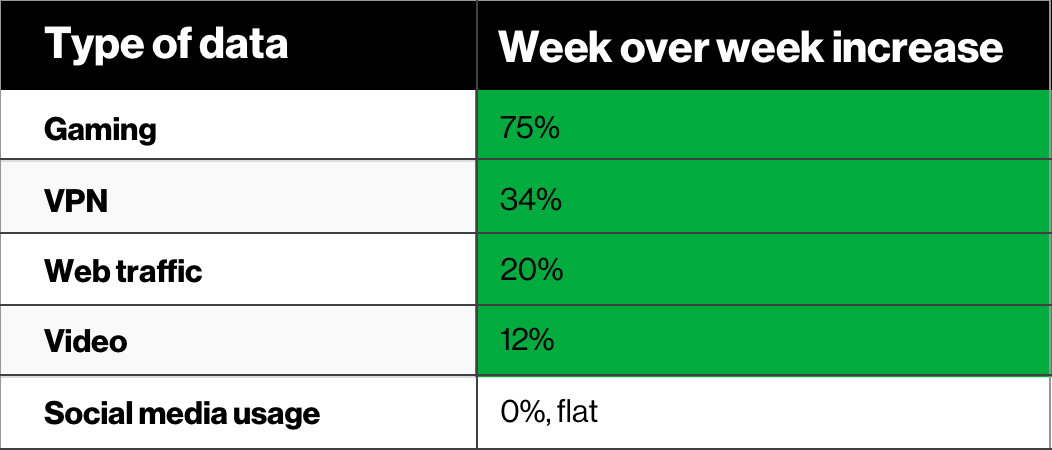
*Based on peak data hour usage week over week.
*Usage is expected to fluctuate over time; we could see new applications emerge based on customer usage patterns as more people telecommute and more students are at home.
“As we see more and more individuals work from home and students engage in online learning, it is a natural byproduct that we would see an increase in web traffic and access to VPN. And as more entertainment options are cancelled in communities across the US, an increase in video traffic and online gaming is not surprising,” said Kyle Malady, Chief Technology Officer for Verizon.“We expect these peak hour percentages to fluctuate, so our engineers are continuing to closely monitor network usage patterns 24×7 and stand ready to adjust resources as changing demands arise.”
“We’re in an unprecedented situation,” said Malady. “We continually evaluate peak data usage times and build our networks to stay ahead of that demand. “While it is not clear yet how having millions of additional people working from home will impact usage patterns, we remain ready to address changes in demand, if needed.”
Updated on 4/02/2020
PR Archives: Latest, By Company, By Date